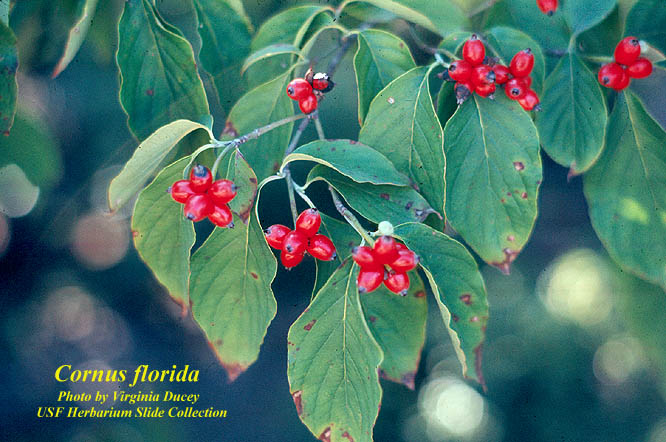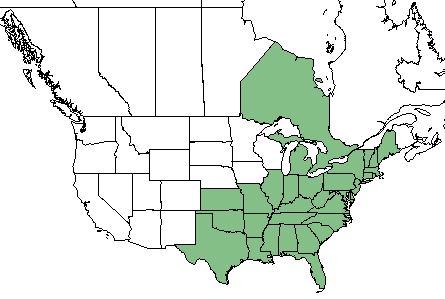Difference between revisions of "Cornus florida"
(→Description) |
|||
| Line 25: | Line 25: | ||
==Description== | ==Description== | ||
<!-- Basic life history facts such as annual/perrenial, monoecious/dioecious, root morphology, seed type, etc. --> | <!-- Basic life history facts such as annual/perrenial, monoecious/dioecious, root morphology, seed type, etc. --> | ||
| − | ''C. florida'' is a perennial shrub/tree of the ''Cornaceae'' family native to North America and Canada. <ref name= "USDA Plant Database"> USDA Plant Database [https://plants.usda.gov/core/profile?symbol=COFL2 https://plants.usda.gov/core/profile?symbol=COFL2] </ref> | + | ''C. florida'' is a perennial shrub/tree of the ''Cornaceae'' family native to North America and Canada. <ref name= "USDA Plant Database"> USDA Plant Database [https://plants.usda.gov/core/profile?symbol=COFL2 https://plants.usda.gov/core/profile?symbol=COFL2] </ref> Bark is grayish brown, reddish brown, or black, rough, broken into square blocks; leaves deciduous, opposite, simple, nearly hairless and smooth to touch on upper surface, finely hairy on bottom surface; inflorescence is many flowers crowded into a head, subtended by 4 large and showy white-pink petal-like bracts; fruit is an elliptical drupe, 1-2 seeded, bright red or yellowish at maturity, usually several are crowded together. <ref name= "Gee 1994"> Gee, K. L., et al. (1994). White-tailed deer: their foods and management in the cross timbers. Ardmore, OK, Samuel Roberts Noble Foundation. </ref> |
==Distribution== | ==Distribution== | ||
Revision as of 14:36, 12 September 2018
Common name: flowering dogwood [1]
| Cornus florida | |
|---|---|

| |
| Photo by the Atlas of Florida Plants Database | |
| Scientific classification | |
| Kingdom: | Plantae |
| Division: | Magnoliophyta - Flowering plants |
| Class: | Magnoliopsida - Dicots |
| Order: | Cornales |
| Family: | Cornaceae |
| Genus: | Cornus |
| Species: | C. florida |
| Binomial name | |
| Cornus florida L. | |

| |
| Natural range of Cornus florida from USDA NRCS Plants Database. | |
Contents
Taxonomic Notes
Synonyms: Cynoxylon floridum (Linnaeus) Rafinesque ex B.D. Jackson; Benthamidia florida (Linnaeus) Spach
Varieties: Cornus kousa House
Description
C. florida is a perennial shrub/tree of the Cornaceae family native to North America and Canada. [1] Bark is grayish brown, reddish brown, or black, rough, broken into square blocks; leaves deciduous, opposite, simple, nearly hairless and smooth to touch on upper surface, finely hairy on bottom surface; inflorescence is many flowers crowded into a head, subtended by 4 large and showy white-pink petal-like bracts; fruit is an elliptical drupe, 1-2 seeded, bright red or yellowish at maturity, usually several are crowded together. [2]
Distribution
C. florida can be found in the south- and mid-eastern United States, as well as the Ontario region of Canada. [1]
Ecology
Habitat
C. florida thrives in dry to moist forests and wetlands [3], and does well in understories. [4]C. florida also proliferates in disturbed areas and rich woods. [5]
Phenology
C. florida has been observed flowering from February to April, October, and November. [6] C. florida is a bird-dispersed species. [7]
Seed dispersal
This species is thought to be dispersed by consumption by vertebrates. [8]
Fire ecology
C. florida is not fire resistant, but has a medium fire tolerance. [1]
Use by animals
C. florida is somewhat palatable to browsing animals, not highly palatable to grazing, and inedible for humans. [1]
Diseases and parasites
C. florida has been impacted since the 1980s by widespread infection by the dogwood anthracnose fungus (Discula destructive). [3]
Conservation and Management
C. florida is listed as endangered by the Maine Department of Conservation Natural Areas Program, exploitably vulnerable by the New York Department of Environmental Conservation, Division of Land and Forests, and threatened by the Vermont Department of Fish and Wildlife Nongame and Natural Heritage Program. [1]
Cultivation and restoration
Photo Gallery
References and notes
- ↑ 1.0 1.1 1.2 1.3 1.4 1.5 USDA Plant Database https://plants.usda.gov/core/profile?symbol=COFL2
- ↑ Gee, K. L., et al. (1994). White-tailed deer: their foods and management in the cross timbers. Ardmore, OK, Samuel Roberts Noble Foundation.
- ↑ 3.0 3.1 Weakley, A. S. (2015). Flora of the Southern and Mid-Atlantic States. Chapel Hill, NC, University of North Carolina Herbarium.
- ↑ Concilio, A., et al. (2005). "Soil respiration response to prescribed burning and thinning in mixed-conifer and hardwood forests." Canadian Journal of Forest Research 35: 1581-1591.
- ↑ URL: http://herbarium.bio.fsu.edu. Last accessed: June 2018. Collectors: Robert K. Godfrey, Gwynn W. Ramsey, Loran C. Anderson, William F. Sheridan, George R. Cooley, Joseph Monachino, J.P. Gillespie, Patricia Elliot, Gary R. Knight, K. Craddock Burks, Richard S. Mitchell, Lovett E. Willimas Jr., R.F. Christensen, C.C. Christensen, John W. Thieret, Windler, Keenan, Lombardo, Williams, A.J. Sharp, Evelyn Sharp, Frank Galyon, Clarke Hudson, R. Kral, R. L. Wyatt, Jerry C. Walters, George T. Jones, Roomie Wilson, Delzie Demaree, James, L. Luteyn, Jack P. Davis, Jewel Moore, W.R. Anderson, M.R. Crosby, Charles S. Wallis, Norlan C. Henderson, Charles Roach, Robert M. Downs, R.D. Whetstone, Mark A. Garland, Jolice Wiedenhoff, N. Summerlin, G. Gil, D.S. Kline, Harry E. Ahles, P. Crutchfield, Lloyd H. Shinners, R.E. Torrey, R.D. Houk, Gerald Poltorak, William D. Reese, C.L. Lundell, Amelia A. Lundell, W.F. Westerfeld, R.W. Booher, T. Sirko, H.A. Wahl, G.W. Parmelee, James R. Coleman, Andrew W. Westling, R.W. Nunan, William B. Masters, Kevin Oakes, Chris Cooksey, R. Komarek, W.M.D. Countryman. States and counties: Leon County Florida, Madison County Florida, Gadsden County Florida, Polk County Florida, Hernando County Florida, Wakulla County Florida, Liberty County Florida, Franklin County Florida, Jackson County Florida, Jefferson County Florida, Murray County Georgia, Iberia County Lousiana, Baltimore County Maryland, Sevier County Tennessee, Evangeline County Louisiana, Calcasieu County Louisiana, Natchitoches County Lousiana, Jefferson Davis County Mississippi, Lincoln County Louisiana, Forsyth County North Carolina, Bulloch County Georgia, Ashland County Ohio, Tangipahoa County Louisiana, Stone County Arkansas, Wake County North Carolina, Blount County Tennessee, Cobb County Georgia, Knox County Tennessee, Oconee County South Carolina, Muskogee County Oklahoma, Boone County Missouri, Morgan County West Virginia, Osage County Missouri, St. Mary County Lousiana, Marshall County Alabama, Stewart County Georgia, Grady County Georgia, Bastrop County Texas, Macon County North Carolina, Barbour County Alabama, Stone County Mississippi, Durham County North Carolina, Harrison County Mississippi, Wayne County Mississippi, Franklin County Massachusetts, Greene County Missouri, Ouachita County Louisiana, Union County Louisiana, Ingham County Michigan, Rapides County Louisiana, Montgomery County Virginia, Cherokee County Texas, Clearfield County Pennsylvania, Huntington County Indiana, Bradford County Pennsylvania, Lafayette County Louisiana, St. Landry County Lousiana, West Feliciana County Louisiana, De Kalb County Georgia, Transylvania County North Carolina, Dallas County Missouri, Thomas County Georgia, Cheshire County New Hampshire.
- ↑ Nelson, G. PanFlora: Plant data for the eastern United States with emphasis on the Southeastern Coastal Plains, Florida, and the Florida Panhandle. www.gilnelson.com/PanFlora/ Accessed: 18 MAY 2018
- ↑ Myster, R. W. and S. T. A. Pickett (1993). "Effects of litter, distance, density and vegetation patch type on post dispersal tree seed predation in old fields." Oikos 66: 381-388.
- ↑ Kirkman, L. Katherine. Unpublished database of seed dispersal mode of plants found in Coastal Plain longleaf pine-grasslands of the Jones Ecological Research Center, Georgia.